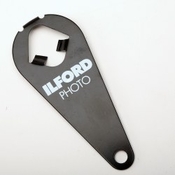dcy
Subscriber
A while ago I took 5 rolls of film and shot a few scenes over and over so I could cut the rolls into pieces and run tests. This is the first roll.
I chose AristaPan 100 because it's very cheap. I figure this is where I'll make the most mistakes, so I picked a film that doesn't hurt the wallet as much. --- Indeed, I struggled opening the can, cutting the film, keeping it clean, etc. But I know what I'll do differently next time. Anyway, I cut 4 pieces and developed in 4 developers:
(1) D-76 1+1 at 20°C for 8:45 min with Ilford agitation.
(2) D-23 1+1 at 20°C for 10:00 min with Ilford agitation.
(3) PC-TEA 1+50 at 20°C for 8:45 min with Ilford agitation.
(4) Barry Thornton's Two Bath at 20°C. Bath A for 4min with Ilford agitation. Bath B for 4min with 5s initial agitation and 5s every in.
Before anyone tells me to pick just one developer ---- Yes, I know. I picked D-23. I am not trying to pick a developer. I am not asking for a developer recommendation.
However, I would appreciate any thoughts you might have on these results. I have 4 other rolls that I've shot but have not developed. So next time I could vary something else, like the development time.
Some quick notes:
(1) You'll see some blotchiness. I do not see when I look at the negatives. I think it's an issue with my scanning process.
(2) You'll see dust specks and similar. I should not have left the negatives to dry in my closet for 5 days. I should have put them in sleeves and then taken them out later.
(3) The scans make the negatives look thinner than they really are. I had set my DSLR to +2 EV from a previous scan and I didn't realize it'd make the negatives look thin. I don't have the energy to start over and redo all the scans.
(4) I did not do any color corrections on post. Normally I'd improve the contrast.
Aside from those flaws (live and learn), here's my take-away:
(1) Honestly, they all look the same to me, and I'm happy with all of them. The third frame shows a slightly denser sky with BTTB. I'm not sure how visible it is on the scan. Developer differences are below my detection threshold.
(2) The grain looks great. I can see it on the sky when I zoom in, and I'm sure I'll notice it in a print, but overall it's great. All the people on Reddit that were dissing on half-frame need to get a life.
(1) D-76 1+1


(2) D-23 1+1


(3) PC-TEA 1+50


(4) Barry Thornton's Two Bath


I chose AristaPan 100 because it's very cheap. I figure this is where I'll make the most mistakes, so I picked a film that doesn't hurt the wallet as much. --- Indeed, I struggled opening the can, cutting the film, keeping it clean, etc. But I know what I'll do differently next time. Anyway, I cut 4 pieces and developed in 4 developers:
(1) D-76 1+1 at 20°C for 8:45 min with Ilford agitation.
(2) D-23 1+1 at 20°C for 10:00 min with Ilford agitation.
(3) PC-TEA 1+50 at 20°C for 8:45 min with Ilford agitation.
(4) Barry Thornton's Two Bath at 20°C. Bath A for 4min with Ilford agitation. Bath B for 4min with 5s initial agitation and 5s every in.
Before anyone tells me to pick just one developer ---- Yes, I know. I picked D-23. I am not trying to pick a developer. I am not asking for a developer recommendation.
However, I would appreciate any thoughts you might have on these results. I have 4 other rolls that I've shot but have not developed. So next time I could vary something else, like the development time.
Some quick notes:
(1) You'll see some blotchiness. I do not see when I look at the negatives. I think it's an issue with my scanning process.
(2) You'll see dust specks and similar. I should not have left the negatives to dry in my closet for 5 days. I should have put them in sleeves and then taken them out later.
(3) The scans make the negatives look thinner than they really are. I had set my DSLR to +2 EV from a previous scan and I didn't realize it'd make the negatives look thin. I don't have the energy to start over and redo all the scans.

(4) I did not do any color corrections on post. Normally I'd improve the contrast.
Aside from those flaws (live and learn), here's my take-away:
(1) Honestly, they all look the same to me, and I'm happy with all of them. The third frame shows a slightly denser sky with BTTB. I'm not sure how visible it is on the scan. Developer differences are below my detection threshold.
(2) The grain looks great. I can see it on the sky when I zoom in, and I'm sure I'll notice it in a print, but overall it's great. All the people on Reddit that were dissing on half-frame need to get a life.
(1) D-76 1+1
(2) D-23 1+1
(3) PC-TEA 1+50
(4) Barry Thornton's Two Bath












